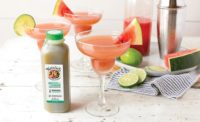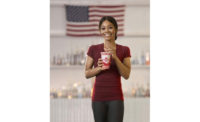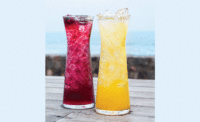Restaurant Beverages Show Signs of Life

Coffee is the beverage behemoth in restaurants, accounting for 2.57 billion servings annually, per the NPD Group, and recent years have seen even fast food chains add specialty coffees to their menus. Flavors such as vanilla and mocha have proven particularly popular among major coffee introductions. Even in a troubled economy, the segment’s major player has seen little negative reaction to a price increase.
Starbucks implemented what it termed a “strategic price increase” in late 2009 and into the first months of 2010, but met with little consumer resistance; in fact, traffic into the coffee giant’s stores consistently improved throughout that time, likely due to the chain’s strategies behind these price increases. As William Blair & Co. noted in a September evaluation, “Starbucks’ methodology of strategically implementing price increases by market and by product and by size will minimize the potential for consumer pushback.”
That said, Starbucks’ results have also benefited from the revamp of its Frappuccinos line. The sugary, iced drinks propelled U.S. sales growth to levels not seen in more than four years. Profits for fiscal 3Q grew 37%, with company CEO Howard Schultz noting the blended beverages Frappuccinos and Vivannos were responsible for about two percentage points of the U.S. gain. In the process, he believes, “A halo effect on the brand helped drive increased sales of bottled Frappuccino for the first time in more than two years.”
Frappuccinos are similar to milkshakes, with some in the line containing no coffee, and contribute about 20% of the company’s total revenue each year (selling in excess of $2 billion). However, after sales peaked in 2006, the company set about revamping the line’s recipe and promoting its customizability. The retooled Frappuccino features fresh milk, higher quality coffee and a lack of either high-fructose corn syrup or undefined “milk ingredients,” but the big selling point is likely the customization possibilities. With milk and coffee added separately for each beverage, Starbucks allows for consumers to specify their Frappuccino exactly to their particular taste, as they can with other Starbucks drinks. While the base mix for light Frappuccinos now includes gluten, the base mix for the regular version does not. The company notes gluten-free Frap lovers who want a reduced-calorie option can request non-fat milk in a regular Frappuccino.
The recipe redux resulted in “thousands of potential new combinations,” including Extra Coffee Caramel (with new Starbucks Frappuccino roast coffee and milk, blended with ice and topped with whipped cream and a swirl of buttery caramel sauce); Mocha Light (with 100, 150 and 200 calories in a Tall, Grande and Venti; combines mocha sauce, roast coffee and skim milk, blended with ice and made with coffee light syrup base); and Soy Strawberries & Crème (a coffee-free, non-dairy version of a classic recipe, adapted to include all-natural strawberry sauce, crème base and soymilk, blended with ice and topped with whipped cream).
Making Change
The recipe change pertained only to in-store Frappuccinos in the U.S. and Canada; however, the company has been tinkering with new flavor possibilities in other parts of the world, including the launch of a black sesame-green tea flavor in China.
The U.S. Frappuccino changes, however, had no impact on the line’s nutrition profile, with the Double Chocolaty Chip Frappuccino still packing 670 calories per 24oz. In addition, Starbucks expanded its frozen treat possibilities further, with its launch of three new ice cream coffee-free flavors inspired by beverages from its coffeehouses, including Vanilla Bean Frappuccino, Signature Hot Chocolate and Strawberries & Crème Frappuccino.
While Starbucks expanded into other segments, it faced increased competition in its bread-and-butter fare, as McDonald’s continues to invest heavily in its own line of coffee and blended beverages. The burger giant has identified a number of non-carbonated beverage opportunities and has established a line of lattes, smoothies and coffee blends, as it aims for a bigger slice of the $153 billion U.S. beverage market (per Ad Age). Setting its sights particularly on Frappuccinos (which account for $2 billion of the $3.2 billion ice blended coffee category, according to Study Logic), McDonald’s developed frappes, lattes, cappuccinos, hot cocoa and even improved its traditional coffee, including “encouraging” franchisees to construct McCafe locations in their restaurants, all part of efforts to become a beverage destination. Executives had hoped the beverage focus would add roughly $125,000 in annual sales per location; according to Morningstar analyst R.J. Hottovy, McDonald’s stores with McCafes are running well ahead of that goal, on average.
The prescribed plan, so far, has been to identify opportunities that have proven successful among smaller chains and adapt them for McDonald’s huge network of restaurant locations. Such is the idea behind its recent foray into frozen juice blends, a staple of Sonic Drive-In’s success; McDonald’s has tested frozen strawberry lemonade in a number of markets. For that matter, the company has made a strong push into smoothies, just as a leading smoothie chain has targeted breakfast as a platform for growth.
Jamba Juice recently introduced its Better Start/Better Day campaign, highlighting breakfast menu offerings, including Hearty Start, Power Start and Balanced Start meal suggestions. The Balanced Start option features a fruit blend topped with granola and bananas, promising antioxidants, flax seed and an açai juice blend, as well as frozen mangos, blueberries and bananas. Meanwhile, Hearty Start adds slow-cooked, steel-cut oatmeal to the chain’s options, in such varieties as apple cinnamon, berry cherry pecan, blueberry & blackberry, fresh banana, and plain oatmeal with brown sugar. In addition, the chain has added its first hot coffee options and now offers organic coffee brewed by the cup. This year also saw a range of retail offerings bearing the Jamba Juice brand, including smoothies and frozen dessert bars promising probiotic cultures and prebiotic fiber.
For its part, McDonald’s introduced its first fruit smoothies to its restaurants over the summer, with strawberry-banana and “wild berry” serving as the debut flavors. As a segment, smoothies sustained steady growth from 2004-2009 and even held relatively strong into the recession, though NPD Group notes servings had declined for the year ending in March. Compared to specialty coffee, smoothies are a small component of the beverage category. NPD notes Americans consumed 422 million servings of smoothies between April 2009-March 2010; in the same time, consumers swallowed 2.57 billion servings of specialty coffee, due in no small part to the consumption growth from the “hamburger” chains. (For that matter, McDonald’s iced coffee and specialty coffees are credited with broadening the demographic reach of the beverages, particularly among 18- to 34-year-olds with incomes lower than those of typical gourmet coffee shop patrons.)
Even a chain better known for its yogurts is expanding into smoothies, as Red Mango has introduced more than 20 smoothie flavors and iced tea-yogurt chillers. The smoothies are made with Red Mango’s tart frozen yogurt, and flavors include strawberry-banana, pomegranate and mango. The chain also will offer “power smoothies” made with protein powder, immunity boosts, energy vitamins, antioxidants and calcium with vitamin D, all of which can have protein, vitamin, energy and probiotic “boosts” added to them. In addition, Red Mango has expanded its line of tea slushes and tea-yogurt chiller blends.
At the same time, Planet Smoothie reformulated its smoothie offerings, switching to a sugar-free chocolate syrup and adding a proprietary stevia and agave sweetener. The result has seen 12oz smoothies that once had 250 calories now boast roughly 180 calories.
However, when it comes to smoothies, early indications are that McDonald’s will face little competition from fast-food competitors, at least for the time being. Chick-fil-A has indicated it will not launch a smoothie, until it can make the beverage more quickly. Wendy’s, in lieu of creating a smoothie line, is expanding its Frosty lineup, adding “Twisted Frosty” options, such as M&M, Oreo, Cookie Dough and Coffee Toffee, as well as such Frosty shakes as chocolate fudge and Frosty-cino. Arby’s, likewise, is focusing on expanding its jamocha shake options.
One of Starbucks’ chief competitors in the coffee segment has been Dunkin’ Donuts, and while the company has introduced smoothies and other new takes on beverages over the years, it has recrafted its popular pumpkin coffees and lattes for the fall. Dunkin’ is also testing a new apple cider steamed in an espresso machine in New England and upstate New York; the drink may also be served on ice.
Similarly introducing fall-oriented items, Coffee Bean & Tea Leaf debuted a range of baked goods and beverages for the autumn season. The chain noted its developers utilized such flavors as pumpkin, pear and cinnamon in the launches, with such new beverages as Cinnamon French Toast in an iced blended drink, Pumpkin Pie latte and a Caramelized Pear latte.
To a Tea
Turning to The Coffee Bean & Tea Leaf’s tea offerings, the company added a Chai Rooibos Tea latte, and, according to Technomic, chai remains among the most popular tea flavors, bested only by green tea but still ahead of peach-, apple- and raspberry-flavored teas. Restaurant menus have featured a diversity of tea offerings, with some of the more novel introductions including Orange Blossom Green Tea from Starbucks, Pomegranate Vanilla Oolong from Caribou Coffee and Perfectly Chocolate Chai Tea Latte from Jamba Juice. The Tea Garden in Minneapolis attempts to capitalize on the personal health trend by offering tea options that provide both health and functional benefits. The five-unit chain focuses on local and natural ingredients and promises “no ‘side-effect’ stimulus.”
As the Technomic data noted, raspberry has proven popular in tea offerings, and Jack in the Box utilized the flavor in a trio of new beverages. Its raspberry smoothie featured raspberry fruit juice, while the raspberry shake blended raspberry syrup and vanilla ice cream, and raspberry iced tea joined Jack’s line of fresh-brewed beverages.
Despite the focus on expanding the range of beverages offered, consecutive years of slumping growth rates are expected to continue in the overall beverages category, according to Technomic Inc. The firm forecasts beverage performance in limited-service restaurants will decline 1.0% in 2010, which at least is less of a decline than that of 2009. (See chart “Beverages Slumping.”) Bars and taverns are expected to grow sales by 1.5%; however, that barely keeps pace with the predicted rate of inflation in 2010. pf
Looking for a reprint of this article?
From high-res PDFs to custom plaques, order your copy today!





